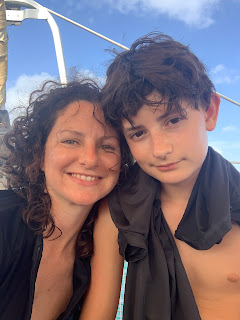What to Eat During Pregnancy
I took my first pregnancy as an excuse to eat whatever I wanted. I gained 60 pounds. With my following three pregnancies, I tried to eat healthy and that included eating as much fresh fruit as I could. All of those babies were nine to ten pounds. My fourth delivery was extremely difficult. He was huge and I really had to work to get him out. I was in fantastic shape, I did yoga every day and I could bend myself into whatever position the midwife requested to help ease the baby out. It is helpful to be limber and strong when going into your labor (more on this in another post) but it is equally important that your baby is a healthy size as well. While I was in the "agonizing about whether or not to have another baby" stage of my fifth child, I called my midwife to see if it was safe for me to have one more. I remembered my labor to be quite difficult and I was worried about future shoulder dystocia, potential cesarean sections, gestational diabetes, etc. She said my labor was not remarkable and that I should be completely fine to have another baby. I was like, "Um, it was remarkable" as I remembered seven hellish hours at eight centimeters dilated and a baby with a swollen black and blue face. She said if I wanted an easier labor, I needed to build a healthier sized baby.
I thought I was being healthy with my fruits and vegetables. She encouraged me to read Real Food for Gestational Diabetes by Lily Nichols. Even though I didn't have gestational diabetes by testing standards, she suspected that I was insulin resistant. Quick little primer about diabetes: we eat glucose in our food. The cells use glucose for energy. In order to get the glucose into the cells, the pancreas pumps out insulin when we eat meals to unlock the cell to allow the glucose to be used as energy. When we eat a lot of glucose over a long period of time, the cells start getting resistant to insulin and not recognizing the signal to take the glucose into the cells for energy. The glucose starts building up in the blood, making the problem worse. You get hungrier because you need that energy and the cycle continues. In late pregnancy, our placenta actually produces hormones that cause insulin resistance in an effort to leave more of the glucose available for growing baby. If you are already insulin resistant either from a high glucose diet or other metabolic reasons, you can develop gestational diabetes which can build a baby that is bigger than they would have been without all of that excess sugar. These babies are used to a steady stream of glucose and often need their blood sugar monitored on delivery. Uncontrolled gestational diabetes is associated with numerous issues (detailed in another post) but I had never been diagnosed so how did this apply to me? Or you?
In early pregnancy, if we can control our intake of carbohydrates (glucose), we can teach our cells to be more sensitive to insulin so that when the inevitable insulin resistance occurs later in pregnancy, our cells will still respond in an appropriate way to glucose. So what does that look like? It means we eat as if we have gestational diabetes from day one. Lily Nichols book outlines healthy food for pregnancy that we should encourage and those that we should avoid. The emphasis is on whole foods, avoiding processed food, decreasing our fruit intake and looking at the glycemic index of foods.
What I avoided:
- most grains (rice, wheat, barley, bread) I did get keto bread from Costco and ate that sparingly. My biggest and worst offender for my blood sugar was white rice. I used black rice if we absolutely had to have it for a recipe the kids wanted. It has a lower carb count. I used net carbs for my carbohydrate counting. This is a big concept in the world of keto. Explanation in in the resources below.
- fruit. This was hard. I did eat berries.
- all processed foods
- sugar (within reason)
- honey
- white potatoes
- corn (I hate it anyway and it is in EVERYTHING)
- normal yogurt (check out the sugar content- it is literally unbelievable)
What I ate:
- lots of eggs
- low carb tortillas (I would actually die if I stopped eating quesadillas)
- keto bread (sparingly)
- berries- low GI (glycemic index)
- whipped cream (home made- its super super easy and you can control the amount of sugar you add)
- stevia packets to add to the whipped cream or other items that absolutely needed sugar added
- dates- (lots about dates on posts about inducing labor)
- so much grass fed butter (if your body isn't using carbs, it is using fats for energy)
- lots of meat (grass fed, pasture raised)
- unsweetened vanilla greek yogurt- full fat
- vegetables, vegetables, vegetables
- nuts
Real for for gestational diabetes: https://realfoodforgd.com/
Science dive on insulin resistance in pregnancy: https://www.ncbi.nlm.nih.gov/pmc/articles/PMC4290225/
The glycemic index: https://glycemicindex.com/
Net carb explaination: https://www.prospectmedical.com/resources/wellness-center/carbs-and-net-carbs#:~:text=Net%20carbs%20are%20the%20carbohydrates,through%20our%20digestion%20system%20unchanged.



Comments
Post a Comment